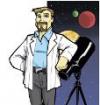Unusually Dusty Galaxy May Be Home To A Quasar

http://www.dearastronomer.com/
Artist’s impression of one of the most distant, oldest, brightest quasars ever seen, hidden behind dust. The quasar dates back to less than one billion years after the big bang. The dust is also hiding the view of the underlying galaxy of stars that the quasar is presumably embedded in. Image Credit: NASA/ESA/G.Bacon, STScI
ASU Astronomers using the Hubble Space Telescope have looked at one of the most distant quasars in the universe. Interestingly enough, said galaxy has such a tremendous amount of dust shrouding it, that viewing the stars which feed the quasar is difficult at best with current technology. The upcoming James Webb Space Telescope might be able to peer through the dust and reveal details of the host galaxy to this dust-obscured quasar.
Quasars (quasi-stellar object) are extremely powerful objects. Powered by the emissions of powerful radiation from a central super-massive black hole, the light can often appear to astronomers on Earth as a jet-like feature. Additionally, if the beam of light emitted from the central black hole points directly at Earth, the accretion disk of material around the black hole, and the resulting “jet” can appear as a quasar, which typically outshine its host galaxy by over a hundred times. The team speculates that the black hole is devouring the equivalent mass of a few suns per year. It may have been eating at a more voracious rate earlier to bulk up to an estimated mass of three billion solar masses in just a few hundred million years.
“If you want to hide the stars with dust, you need to make lots of short-lived massive stars earlier on that lose their mass at the end of their lifetime. You need to do this very quickly, so supernovae and other stellar mass-loss channels can fill the environment with dust very quickly,” said Rogier Windhorst of Arizona State University (ASU), Tempe, Ariz. “You also have to be forming them throughout the galaxy to spread the dust throughout the galaxy,” added Matt Mechtley, also of ASU.
By using a nearby “reference” star, the team was able to carefully subtract light from the quasar image. Once the quasar was removed, the team was unable to detect any significant starlight in the region of the quasar. Had there not been any dust obscuring the stars, the stars would have been easily detected.
“It is remarkable that Hubble didn’t find any of the underlying galaxy,” said Windhorst. “The underlying galaxy is everywhere much fainter than expected, and therefore must be in a very dusty environment throughout. It’s one of the most rip-roaring forest fires in the universe. It’s creating so much smoke that you’re not seeing any starlight, anywhere. The forest fire is complete, not a tree is spared.”
“Because we don’t see the stars, we can rule out that the galaxy that hosts this quasar is a normal galaxy,” said Mechtley. “It’s among the dustiest galaxies in the universe, and the dust is so widely distributed that not even a single clump of stars is peeking through. We’re very close to a plausible detection, in the sense that if we had gone a factor of two deeper we might have detected some light from its young stars, even in such a dusty galaxy.”
The team’s results were published in the Sept 10th issue of the Astrophysical Journal Letters in a paper by M. Mechtley, R. Windhorst, and an international team of collaborators.
There are plans to observe this object with the upcoming James Webb Space Telescope. “The Webb telescope is designed to make a definitive detection of this,” said Windhorst. We will get solid detections of the stars with Webb’s better sensitivity to longer wavelengths of light, which will better probe the dusty regions in these young galaxies.
If you’d like to read the team’s full research paper, visit: http://arxiv.org/abs/1207.3283
Source: NASA James Webb Space Telescope News
Ray Sanders is a Sci-Fi geek, astronomer and blogger. Currently researching variable stars at Arizona State University, he writes for Universe Today, The Planetary Society blog, and his own blog, Dear Astronomer
2012-12-04 08:08:11
Source: http://www.dearastronomer.com/2012/10/23/unusually-dusty-galaxy-may-be-home-to-a-quasar/
Source:
Anyone can join.
Anyone can contribute.
Anyone can become informed about their world.
"United We Stand" Click Here To Create Your Personal Citizen Journalist Account Today, Be Sure To Invite Your Friends.
Please Help Support BeforeitsNews by trying our Natural Health Products below!
Order by Phone at 888-809-8385 or online at https://mitocopper.com M - F 9am to 5pm EST
Order by Phone at 866-388-7003 or online at https://www.herbanomic.com M - F 9am to 5pm EST
Order by Phone at 866-388-7003 or online at https://www.herbanomics.com M - F 9am to 5pm EST
Humic & Fulvic Trace Minerals Complex - Nature's most important supplement! Vivid Dreams again!
HNEX HydroNano EXtracellular Water - Improve immune system health and reduce inflammation.
Ultimate Clinical Potency Curcumin - Natural pain relief, reduce inflammation and so much more.
MitoCopper - Bioavailable Copper destroys pathogens and gives you more energy. (See Blood Video)
Oxy Powder - Natural Colon Cleanser! Cleans out toxic buildup with oxygen!
Nascent Iodine - Promotes detoxification, mental focus and thyroid health.
Smart Meter Cover - Reduces Smart Meter radiation by 96%! (See Video).





